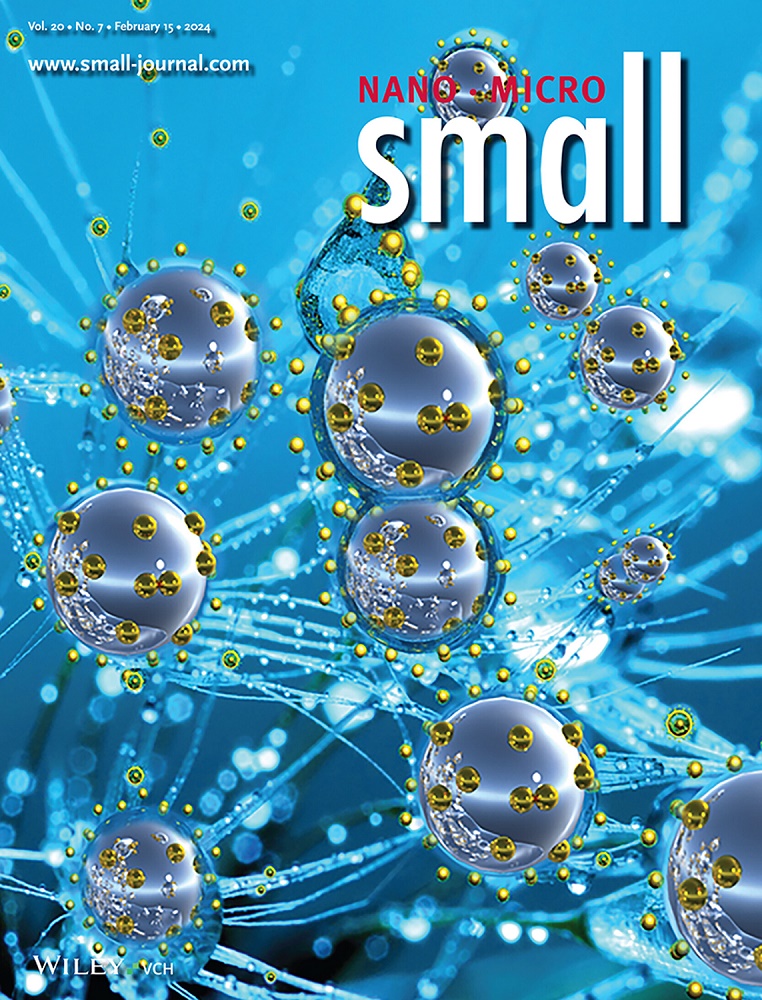利用微流控挤压构建的磁性基因工程细胞高效捕获循环肿瘤细胞。
IF 12.1
2区 材料科学
Q1 CHEMISTRY, MULTIDISCIPLINARY
引用次数: 0
摘要
循环肿瘤细胞(CTC)检测对于早期肿瘤诊断和实时转移监测至关重要。用于CTC富集的传统免疫磁性纳米材料(IMNs)存在纯度低、效率低等局限性。尽管已经探索了细胞膜包被的imn以减少非特异性白细胞结合,但挑战仍然存在,包括高膜消耗,低封装效率和不可预测的膜取向。本文开发了一种负载编码抗epcam单链可变片段(scFv)的质粒的聚乙烯亚胺包被磁性纳米颗粒(PEI-MNPs)。为了增强细胞内传递,设计了一种微流控芯片,其流控通道垂直于主窄通道,诱导细胞瞬态变形,提高纳米颗粒的摄取。一旦内化,PEI-MNPs促进抗epcam scFv的细胞内表达,实现ctc的精确识别和磁分离。这种流线型的微流体方法实现了高通量、高效的磁加载和靶细胞的基因工程。该方法显著提高了CTC的富集,纯度为91.9%,而市售IMNs的纯度为61.2%。通过利用完整细胞作为IMN包封的仿生载体,该策略有效地模拟了体内受体-配体的相互作用,并最大限度地减少了非特异性白细胞的吸附。本研究为高纯度CTC的分离提供了一种新的高效方法,为早期癌症诊断和转移监测提供了良好的前景。本文章由计算机程序翻译,如有差异,请以英文原文为准。
Magnetic Genetically Engineered Cells Constructed via Microfluidic Squeezing for Highly Efficient Capture of Circulating Tumor Cells.
Circulating tumor cell (CTC) detection is crucial for early cancer diagnosis and real-time metastasis monitoring. Conventional immunomagnetic nanomaterials (IMNs) used for CTC enrichment face limitations such as low purity and inefficiency. Although cell membrane-coated IMNs have been explored to reduce nonspecific leukocyte binding, challenges persist, including high membrane consumption, low encapsulation efficiency, and unpredictable membrane orientation. Here, polyethyleneimine-coated magnetic nanoparticles (PEI-MNPs) loaded with a plasmid encoding an anti-EpCAM single-chain variable fragment (scFv) is developed. To enhance intracellular delivery, a microfluidic chip with a fluidic channel oriented perpendicular to the main narrow channel, inducing transient cellular deformation and improving nanoparticle uptake is designed. Once internalized, the PEI-MNPs facilitate intracellular expression of anti-EpCAM scFv, enabling precise recognition and magnetic separation of CTCs. This streamlined microfluidic approach achieves high-throughput, efficient magnetic loading, and genetic engineering of target cells. This method significantly improves CTC enrichment, yielding a purity of 91.9%, compared to 61.2% with commercially available IMNs. By utilizing intact cells as biomimetic carriers for IMN encapsulation, this strategy effectively mimics receptor-ligand interactions in vivo and minimizes nonspecific leukocyte adsorption. This work presents a novel and efficient approach for high-purity CTC isolation, offering promising potential for early cancer diagnosis and metastasis monitoring.
求助全文
通过发布文献求助,成功后即可免费获取论文全文。
去求助
来源期刊

Small
工程技术-材料科学:综合
CiteScore
17.70
自引率
3.80%
发文量
1830
审稿时长
2.1 months
期刊介绍:
Small serves as an exceptional platform for both experimental and theoretical studies in fundamental and applied interdisciplinary research at the nano- and microscale. The journal offers a compelling mix of peer-reviewed Research Articles, Reviews, Perspectives, and Comments.
With a remarkable 2022 Journal Impact Factor of 13.3 (Journal Citation Reports from Clarivate Analytics, 2023), Small remains among the top multidisciplinary journals, covering a wide range of topics at the interface of materials science, chemistry, physics, engineering, medicine, and biology.
Small's readership includes biochemists, biologists, biomedical scientists, chemists, engineers, information technologists, materials scientists, physicists, and theoreticians alike.
 求助内容:
求助内容: 应助结果提醒方式:
应助结果提醒方式:


